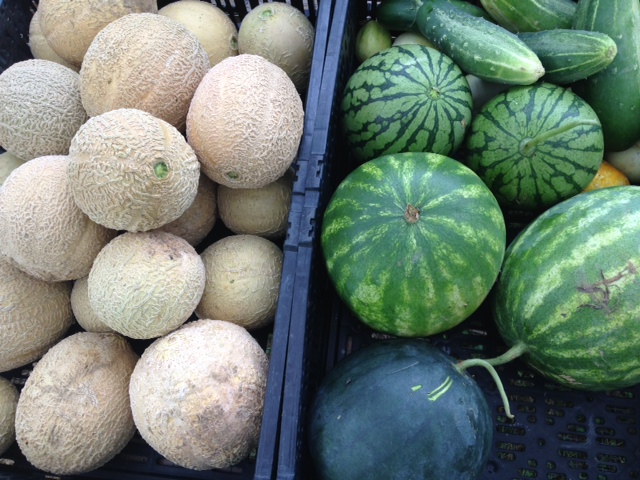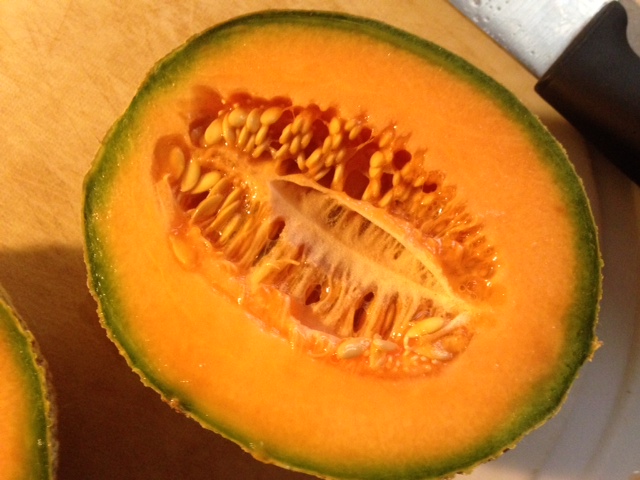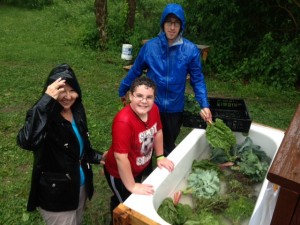If you come visit my stand at the farmers market, you may notice that some of my veggies are on the petite side. That’s because I use my “little pumpkin” philosophy all throughout the garden. My celery is small. So are my eggplants, beets, cabbages, and a bunch of other vegetables. Sometimes it’s because I grow small varieties and plant things close together so I can fit a lot of vegetables in a small space, but oftentimes it’s because I don’t use fertilizer and extra water on the plants. I believe the result is nutrient-dense and flavorful (and not watery) food. Sometimes bigger isn’t always better…sometimes good things come in small packages.
Melon Mistakes
Melon season arrived on the farm last week, and it seems like it will only last another week or so. It’s a flash in the pan, but a sweet and juicy flash in the pan. I have never grown melons before this year. In the Pacific Northwest, where I learned most of my farming skills, it was difficult to grow melons because they like prolonged hot weather. I’ve learned a lot of lessons about growing melons (both cantaloupe and watermelons) this year, mostly from screwing up, so I thought I would share my screw-ups with you all so you too can learn from my mistakes.

Our first melon harvest for market was August 9. Jackpot!
I thought any melon with orange flesh and tan, rough skin was a cantaloupe. That’s not true! Cantaloupes are a specific type of muskmelon. Other muskmelons include honeydew and Armenian cucumbers. The name refers to the fragrant odor that these melons release when ripe. Technically, the term cantaloupe refers to a specific type of muskmelon from Europe with orange flesh, but no ribs or netting. However, we have more recently accepted the term cantaloupe for all of the sweet, orange fleshed muskmelons with netting and ribs that are so popular in North America. Who knew? Not me, until I read the descriptions of muskmelons and cantaloupes in seed catalogs this winter.

Melons, like their cousins, squash and cucumbers, have very long vines with large leaves. These plants do a great job of spreading and making a canopy of huge leaves, under which weed seeds have a difficult time germinating. Assuming that my baby melon plants would take off and out compete the weeds, I put “weeding the melons” very low on my priority list. The result? My melon patch is the weediest spot on the farm. Name the weed, and I’ve got it in my melon patch. Every time I harvest cantaloupes and watermelons, I feel like I’m on a treasure hunt. As fun as that is, it probably takes me 5 times longer to harvest melons than it would if I could actually see them sitting on the ground.

My favorite variety of watermelon is a small little yellow-fleshed watermelon called Petite Yellow. They are so sweet, and just the right size for two people to eat in one sitting. Another bonus – they are almost all flesh with very thin rinds. However, their sweet aroma and thin rinds makes them prime candidates for a late night deer snack. Just before all my Petite Yellow watermelons ripened, deer wiped them all out…ate the whole things and left only a tiny bit of rind on the ground. I managed to salvage one Yellow Petite that was well hidden under my weed canopy, and a couple more have grown since the major deer attack in mid-July, thankfully. I’m saving these little jewels to eat myself!

In mid-July after the deer attack on my Petite Yellow melons, I was gripped with fear that the deer would eat all of my melons, so I decided to start harvesting them. After all, if the deer were sniffing them out, they must be ripe, right?! Wrong. I picked two Sugar Baby watermelons and cut them open. One was completely white inside and the other was barely pink. Interestingly, they were still sweet. Not as sweet as a fully ripe melon, but still very edible. I decided to wait a couple more weeks, keep my fingers crossed that the deer would leave them alone. Luckily, the deer ignored them and I started finding ripe watermelons about two weeks ago. Of course, I had to taste test them before I brought them to market, so I didn’t begin selling any until last week. I have learned a few tips for identifying ripe melons. Watermelons have a little curly tendril that grows across the vine from their stems. When this tendril dries up and turns brown, your melon is likely ready, but you still want to look for a yellowish spot where the melon sat on the ground, and listen for a hollow sound when the melon is thumped. When all three of these signs have coincided, I have found nicely ripe melons. For cantaloupe, you can sniff the melons, and a strong sweet scent indicates they are ripe, plus they will slip right off the vine with barely any pressure. I have noticed that size doesn’t indicate ripeness; I have found large under-ripe melons, and tiny fully-ripe melons. It seems that size may have more to do with how much water the plant received than ripeness. I didn’t irrigate my melons at all, and they are smaller than average, but REALLY sweet, and still juicy. I think the lack of irrigation helped to concentrate the sugars rather than making a huge, watery melon.

Because I wait to pick my cantaloupes until they are super sweet, fragrant, and slip right off the vine, they have a very short shelf life. They seem to develop soft spots overnight. Although this makes them difficult to sell, I have found that they are still very good, and only need a little of the soft spots cut off. Even so, I haven’t been selling any of my cantaloupes that have bad soft spots. Instead, I have been eating them and giving them away to family and friends. In fact, I just cut up two of them and am trying out a recipe for melon sorbet. It calls for vodka. I’m not sure if that helps the sorbet reach the correct consistently, or it’s just to add a little livelihood to my dessert, but I didn’t question it, and I now have vodka-y, lemony, melon puree in my refrigerator cooling before I put it in my ice cream maker. You can try it out with watermelon too, or a mix of cantaloupe and watermelon. Cheers!
Water
Water has been on my mind lately. Mainly because I was worried that my plants weren’t getting enough of it during the final weeks of May. Until a few days ago, the top few inches of soil in the garden were turning dusty dry and the flow of the creeks running alongside my garden had turned from a gush into a trickle. While neighboring farms were busy irrigating their crops, I was busy doing a rain dance because…full disclosure here…I don’t have an irrigation system set up yet. I have a long to-do list for the farm, and setting up irrigation has been on that to-do list for a long time. I kept shuffling it to the bottom of the list because Mother Nature has been providing consistent rain or thundershowers (or snow) since my first seeds and plant babies went out into the field in March. So instead of looking my irrigation (or lack of irrigation) problem in the eye, I focused on other farm projects. Also, I have to admit, irrigation is a topic that makes my head spin, which is probably why I have procrastinated so long.
To irrigate crops, you need a water source and power to deliver the water to the crops. While I’m lucky that I have creeks bordering three sides of my farm, they don’t always hold water consistently throughout the year, and I don’t have an electric source anywhere near my field, so I need to have an alternative power source to pump water from the creeks. Another disclosure – I would rather not have to water at all. If I can get all of my water in the form of rain, it saves me a lot of time and worry. Plus, plants tend to be better at growing deep, water-seeking roots if you don’t water them too much. If the surface of the soil is consistently wet from regular irrigation, the plants will form shallow roots that stay near the surface and easily dry out when they aren’t irrigated. Normally, here in Kentucky, you can bet on warm rains throughout the summer, but we have experienced drought years, and who knows what will happen this summer, so I’m biting the bullet and buying irrigation equipment in case we have an unusually dry summer. Now I’m tackling the confusing-to-me subjects of water pressure, friction loss, filtration, and the puzzle of putting together pumps, fittings, pipes, hoses, valves, and nozzles. On top of all that, I have struggled to find a local irrigation supply store that carries agricultural irrigation products for small scale growers. There sure do seem to be a lot of lawn irrigation contractors and suppliers out there, but not a lot of options for people growing things other than grass. The nearest agricultural irrigation store I could find was in Lexington. I could try and order everything online, but I really wanted to talk to an expert and see how all those little fittings, hoses, and whoozeewhatsits go together before I purchased them. So, earlier this week after some hot days with no rain, I decided to drive to Lexington and talk to the fine people at Kentucky Irrigation. Now I’m the proud owner of some drip tape, a filter, pressure regulator, and various fittings. I still need to purchase a pump and a large diameter hose or pipes to deliver water from the pump up the field, but all of that can wait a little longer because my rain dance paid off – on Wednesday, we received an inch of rain. As luck might have it, most of it fell during the few hours we have to harvest vegetables for our Wednesday farmers market, but I’m not complaining. The plants are thriving now in moist soil and I get to procrastinate my irrigation problem for a little longer.




